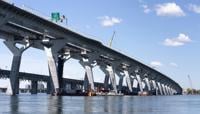MONTREAL - Climate change is likely to increase the frequency of weather events that cause landslides in Quebec, like the one that killed two people a week ago in the Saguenay—Lac-St-Jean region, said a researcher who studies natural risks.
Jacques Locat, a professor emeritus at Université Laval, says climate change models predict that southern Quebec will receive between five per cent and 14 per cent more rain by 2050. His research suggests that increase in precipitation, coupled with an expected rise in extreme rain events, will make the occurrence of landslides in the province more likely.
"The impact of climate change on landslides in Quebec will be mainly related to precipitation," Locat, co-founder of a research laboratory at the university that studies natural risks, said in a recent interview.
On Saturday, torrential rain in Quebec's Saguenay—Lac-St-Jean region contributed to several landslides, including one that led to the death of two people. That landslide, Locat said, appears to have been caused by erosion along the Éternité River and saturation of the embankment above the river, both of which triggered sandy material on top of the clay soil to slide downward.
Quebec risks having more "superficial landslides," Locat said, which generally involve soil conditions that are particularly susceptible to erosion and to being rapidly saturated with water.
Locat said two factors lead to superficial landslides: erosion of soil at the bottom of slopes — caused by water but also human activity — which makes them more steep, and saturation of the soil at the top of slopes, which causes material to slide downward.
"Erosion is the trigger of many landslides along watercourses and so climate change could have an effect on the frequency and significance of water level increases and, perhaps, an impact on superficial landslides," Locat said.
About 40 per cent of landslides in Quebec's St. Lawrence River valley — a region where they are particularly common in the province — are caused by erosion that is the result of human activities, he said. Landslides also occur around Gatineau, Que., near Ottawa; in the Charlevoix region, northeast of Quebec City; and the Gaspé Peninsula.
All of those regions are located on a clay plain left by a sea that disappeared around 10,000 years ago. That clay soil can become unstable, and landslides are part of the natural evolution of that type of landscape, Locat said.
Scott McDougall, a professor at the University of British Columbia who studies landslides and related geohazards, said those clay soils are very sensitive. "When they get disturbed, their structure can change, basically turning them from a solid into a fluid that can flow long distances," he said.
McDougall, like Locat, also posits that climate change will increase the likelihood of landslides in Quebec; but he said research to support that hypothesis is ongoing.
"We think that more frequent rainfall or more intense rainfall is going to make landslides more frequent and potentially more intense themselves," he said. "A really unusually heavy rainfall could trigger an unusually large landslide."
Wildfires can also contribute to landslides, he said, by changing the vegetation cover and soil conditions, leading to more water infiltration and killing trees whose roots hold the soil together.
Landslides are also common in Quebec's Saguenay region. Last summer, more than 70 households were evacuated in La Baie, Que., part of the city of Saguenay, after a landslide destroyed an empty house, and officials feared further slides. In 1971, a landslide in another part of that city killed 31 people and led to the abandonment of the community of St-Jean-Vianney.
Locat said what is likely the deadliest landslide in Quebec's history occurred in 1908 in Notre-Dame-de-la-Salette, Que., about 40 kilometres northeast of Ottawa, and killed 33 people. However, Locat, who studied the event for a 2017 paper, found that the landslide occurred across the river from the town and triggered a sort of "tsunami" that projected ice onto the community and caused the deaths.
Research published by Natural Resources Canada in May 2021 showed that between 1771 and 2019, Quebec had the second highest number of deadly landslides in the country: 239. Only British Columbia had more, with 356. Quebec was followed by Newfoundland and Labrador, which had experienced 103, and Alberta, where there were 73.
But Locat said Quebec may have a higher number of recorded landslides than other parts of the country because of its settlement patterns. Around 80 per cent of Quebec's population lives on the clay plain where landslides occur, he said, adding that the province was settled earlier than other parts of Canada, allowing Quebecers a more extended opportunity to record the phenomenon compared with other Canadians.
This report by Ďă¸ŰÁůşĎ˛ĘąŇĹĆ×ĘÁĎ was first published July 7, 2023.








































